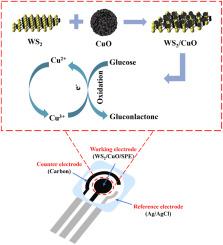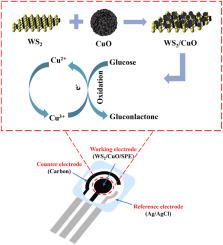基于WS2/ cuo的无酶传感器检测汗液中的葡萄糖
IF 6
2区 化学
Q1 CHEMISTRY, ANALYTICAL
引用次数: 0
摘要
传统的血糖监测需要穿刺皮肤获取血液样本,这给糖尿病患者带来了不便和不适。汗液葡萄糖含量已被证实与血糖浓度相关,因此汗液葡萄糖检测在无创血糖监测中具有显著优势。基于酶的葡萄糖传感器的性能容易受到温度、ph等外界环境的影响,因此迫切需要开发稳定性好、成本低、性能好的非酶葡萄糖传感器用于汗液葡萄糖检测。结果将氧化铜(CuO)纳米颗粒与二硫化钨(WS2)纳米片相结合,制备了一种非酶解葡萄糖传感器。通过扫描电子显微镜(SEM)和电化学测量对传感器进行了表征,结果表明WS2/CuO纳米复合材料形成了蜂窝状表面,提高了葡萄糖的催化能力。实验发现,在0.1 mM ~ 2 mM和2 mM ~ 20 mM范围内,传感器响应信号与目标浓度分别呈线性关系,在优化实验条件下,相应的检测灵敏度分别为311.23 μA mM-1 cm-2和238.3 μA mM-1 cm-2。传感器的检测限低至0.65 μM。该传感器还具有良好的选择性、重复性、再现性和稳定性。最后,将该传感器应用于人工汗液和人体汗液中葡萄糖的检测。实验结果与分光光度法的对比表明,本研究提出的非酶葡萄糖传感器在检测真实汗液样品分析中具有良好的准确性,突出了其在未来实际应用中的巨大潜力。本文章由计算机程序翻译,如有差异,请以英文原文为准。


WS2/CuO-based non-enzymatic sensor for the detection of glucose in sweat
Background
Traditional blood glucose monitoring requires piercing the skin to obtain blood samples, which brings inconvenience and discomfort to diabetic patients. Sweat glucose content has been proven to be related to blood glucose concentration, so sweat glucose detection shows significant advantages in non-invasive blood glucose monitoring. The performance of enzyme-based glucose sensors is easily affected by external environments such as temperature and pH. Therefore, there is an urgent need to develop non-enzymatic glucose sensors with good stability, low cost and high performance for sweat glucose detection.
Results
In this study, a non-enzymatic glucose sensor had been successfully fabricated by integrating copper oxide (CuO) nanoparticles with tungsten disulfide (WS2) nanosheets obtained via a liquid-phase exfoliation method. The sensor was characterized using scanning electron microscopy (SEM) and electrochemical measurements, showing that WS2/CuO nanocomposites formed a honeycombed-like surface improving the catalytic ability of glucose. The fabricated non-enzymatic amperometric glucose sensor is capable of detecting a wide range of target concentrations, from 0.1 mM to 20 mM. The experiment found that the sensor response signal has a linear relationship with the target concentration in the range of 0.1 mM–2 mM and 2 mM–20 mM, respectively, and the corresponding detection sensitivities are 311.23 μA mM−1 cm−2 and 238.3 μA mM−1 cm−2 under optimized experimental conditions. The sensor has a detection limit as low as 0.65 μM. The sensor also has good selectivity, repeatability, reproducibility and stability. Finally, the fabricated sensor was applied to the detection of glucose in artificial sweat and human sweat.
Significance
The experimental results compared with the spectrophotometric method illustrate the excellent accuracy of the non-enzymatic glucose sensor proposed in this study in detecting real sweat sample analysis, highlighting its great potential for future practical applications.
求助全文
通过发布文献求助,成功后即可免费获取论文全文。
去求助
来源期刊

Analytica Chimica Acta
化学-分析化学
CiteScore
10.40
自引率
6.50%
发文量
1081
审稿时长
38 days
期刊介绍:
Analytica Chimica Acta has an open access mirror journal Analytica Chimica Acta: X, sharing the same aims and scope, editorial team, submission system and rigorous peer review.
Analytica Chimica Acta provides a forum for the rapid publication of original research, and critical, comprehensive reviews dealing with all aspects of fundamental and applied modern analytical chemistry. The journal welcomes the submission of research papers which report studies concerning the development of new and significant analytical methodologies. In determining the suitability of submitted articles for publication, particular scrutiny will be placed on the degree of novelty and impact of the research and the extent to which it adds to the existing body of knowledge in analytical chemistry.
 求助内容:
求助内容: 应助结果提醒方式:
应助结果提醒方式:


